《汽车驾驶手册》[大嘴车坛]
汽车驾驶完全手册
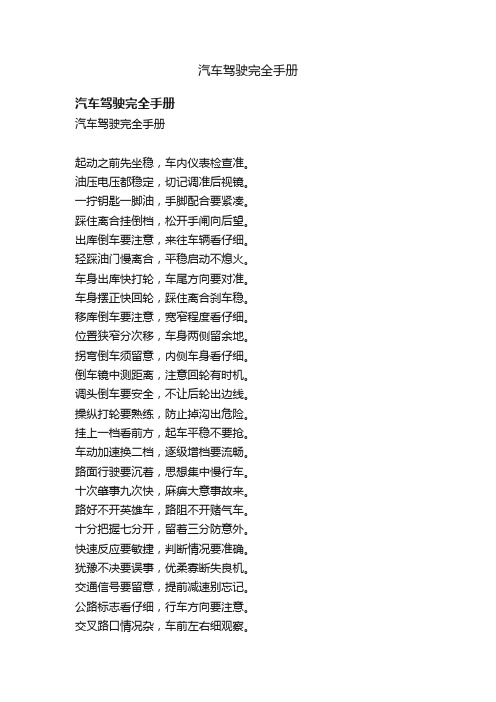
汽车驾驶完全手册汽车驾驶完全手册汽车驾驶完全手册起动之前先坐稳,车内仪表检查准。
油压电压都稳定,切记调准后视镜。
一拧钥匙一脚油,手脚配合要紧凑。
踩住离合挂倒档,松开手闸向后望。
出库倒车要注意,来往车辆看仔细。
轻踩油门慢离合,平稳启动不熄火。
车身出库快打轮,车尾方向要对准。
车身摆正快回轮,踩住离合刹车稳。
移库倒车要注意,宽窄程度看仔细。
位置狭窄分次移,车身两侧留余地。
拐弯倒车须留意,内侧车身看仔细。
倒车镜中测距离,注意回轮有时机。
调头倒车要安全,不让后轮出边线。
操纵打轮要熟练,防止掉沟出危险。
挂上一档看前方,起车平稳不要抢。
车动加速换二档,逐级增档要流畅。
路面行驶要沉着,思想集中慢行车。
十次肇事九次快,麻痹大意事故来。
路好不开英雄车,路阻不开赌气车。
十分把握七分开,留着三分防意外。
快速反应要敏捷,判断情况要准确。
犹豫不决要误事,优柔寡断失良机。
交通信号要留意,提前减速别忘记。
公路标志看仔细,行车方向要注意。
交叉路口情况杂,车前左右细观察。
交通规章要牢记,出事就在一两米。
并道之前打转向,后视镜里看车辆。
车辆尾随可转向,侧面有车让一让。
躲避打轮要灵活,高速行车把稳舵。
车速慢减要换档,及时减档才正常。
窄道会车靠边行,注意行人随时停。
转弯减速不能急,脚搭刹车别大意。
人多车多别硬挤,不要生气不能急。
手忙脚乱发脾气,一旦出事来不及。
刹车之前挂空档,减速滑行不匆忙。
快道行车有四忌,每条必须要牢记。
一忌超速快行车,二忌压速慢行车。
三忌思想开小差,四忌路口右转弯。
超车之前看车辆,道路畅通左转向。
鸣笛加速超车急,猛踩油门别犹豫。
转向减速再回道,后面车辆要关照。
雨天路面视距差,注意减速防侧滑。
雾天能见度太差,宽示灯开防碰擦。
夜间行车麻烦多,身体疲惫别开车。
农村公路比较窄,控制车速不能快。
遇到牲畜别惊吓,不鸣喇叭让一下。
掌握车距很重要,行车安全很有效。
沉着灵活别着急,全凭目测有距离。
车速较快远距离,以防刹车来不及。
出租车后远距离,随时停车要注意。
汽车驾驶员安全驾驶手册
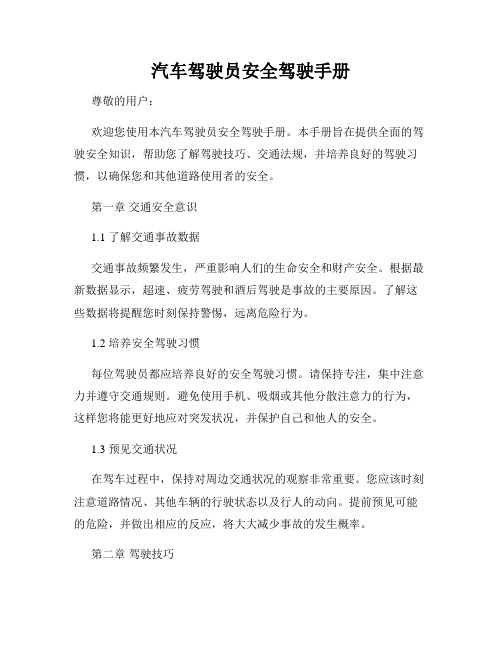
汽车驾驶员安全驾驶手册尊敬的用户:欢迎您使用本汽车驾驶员安全驾驶手册。
本手册旨在提供全面的驾驶安全知识,帮助您了解驾驶技巧、交通法规,并培养良好的驾驶习惯,以确保您和其他道路使用者的安全。
第一章交通安全意识1.1 了解交通事故数据交通事故频繁发生,严重影响人们的生命安全和财产安全。
根据最新数据显示,超速、疲劳驾驶和酒后驾驶是事故的主要原因。
了解这些数据将提醒您时刻保持警惕,远离危险行为。
1.2 培养安全驾驶习惯每位驾驶员都应培养良好的安全驾驶习惯。
请保持专注,集中注意力并遵守交通规则。
避免使用手机、吸烟或其他分散注意力的行为,这样您将能更好地应对突发状况,并保护自己和他人的安全。
1.3 预见交通状况在驾车过程中,保持对周边交通状况的观察非常重要。
您应该时刻注意道路情况、其他车辆的行驶状态以及行人的动向。
提前预见可能的危险,并做出相应的反应,将大大减少事故的发生概率。
第二章驾驶技巧2.1 手握方向盘的正确姿势正确的手握方向盘姿势有助于驾驶者更好地掌控车辆。
请双手握住方向盘两侧,将大拇指放在外侧,将其他手指环绕在方向盘上。
保持放松的状态,避免使用力气过大或过小。
2.2 正确使用安全带使用安全带是保护自己和乘客的重要手段。
请确保所有座位上的人员都系好安全带,而且安全带应佩戴在正确的位置上,贴合身体,避免碰撞时产生二次伤害。
2.3 安全超车技巧超车是驾驶中常见的操作,但也是许多交通事故的起因。
在超车时,请始终保持足够的安全距离,并使用转向灯提前示意。
在确保没有来车的情况下,迅速超越前车,并尽快回到原车道。
第三章交通法规3.1 了解交通标志和标线交通标志和标线是引导车辆行驶和指示道路状况的重要标识。
您需要充分了解各种标志和标线的含义,并在行驶过程中按规定遵守。
这将确保您的驾驶行为合法且安全。
3.2 遵守速度限制速度限制是确保道路交通安全的重要措施之一。
请时刻关注道路上的速度限制标志,并根据实际道路情况调整车速。
汽车驾驶手册.pdf_1702098639.274049说明书

distances will be longer and vehicle control more limited.While driving on a surface with reduced traction, avoid maneuvers involving sudden steering,acceleration, or braking (including engine braking due to shifting to lower gear), that could cause the tires to skid.Drivers may not realize the surface is slippery until the vehicle is skidding.Learn to recognize warning clues—such as enough water or ice on the road to make a"mirrored surface"—and slow down when there is any doubt.Also see "Traction" under "Tires"in this section.To safely operate your vehicle,your tires must be the proper type and size, in good condition with adequate tread, and correctlyinflated. The following pages give more detailed information on how and when to check air pressure,how to inspect your tires fordamage and wear, and what to do when your tires need to be replaced.Driving TipsRapid slowing down orspeeding-up can cause loss of control on slipperysurfaces. If you crash, you can be injured.Use extra care when driving on slippery surfaces.InflationKeeping the tires properly inflated provides the best combination of handling, tread life, and riding comfort. Underinflated tires wear unevenly, adversely affect handling and fuel economy, and are more likely to fail from being overheated.Overinflated tires can make your vehicle ride more harshly, are more prone to damage from road hazards, and wear unevenly.We recommend that you visually check your tires every day. If you think a tire might be low, check it immediately with a tire e a gauge to measure the air pressure at least once a month.Even tires that are in goodcondition may lose one to two psi per month. Remember to check the spare tire at the same time you check all the other tires.Check the pressure in the tires when they are cold. This means the vehicle has been parked for at least three hours. If you have to drive the vehicle before checking the tire pressure, the tires can still be considered "cold" if you drive less than 1 mile (1.6 km).If you check the pressure when the tires are hot (the vehicle has been driven several miles), you will see readings 4 to 6 psi (28 to 41 kPa, 0.3 to 0.4 kg/cm 2) higher than the cold reading. This is normal. Do not let air out tomatch the specified cold pressure.The tire will be underinflated.You should get your own tire pressure gauge and use it at all times. That makes it easier for you to tell if a pressure loss iscaused by a tire problem and not a variation between gauges.Recommended Tire Pressures for Normal DrivingThe following chart shows the recommended cold tire pressures for most normal driving conditions and speeds.Driving TipsThese pressures are also given on the tire information label on the driver's doorjamb.Tubeless tires have some ability to self-seal if they are punctured.However, because leakage is often very slow, you should look closely for punctures if a tire starts losing pressure.InspectionEvery time you check inflation,you should also examine the tires for damage, foreign objects, and wear.You should look for:Bumps or bulges in the tread or side of the tire. Replace the tire if you find either of theseconditions.Cuts, splits, or cracks in the side of the tire. Replace the tireif you can see fabric.Excessive tread wear.Your vehicle's tires have wear indicators molded into the tread.When the tread wears down to that point, you will see a 1/2 inch (12.7mm) wide band running across the tread. This shows that there is less than 1/16 inch (1.6 mm) of tread left on the tire. A tire that is this worn gives very little traction on wet roads. You should replace the tire if you can see the tread wearDriving TipsLABELTREAD WEARINDICATORSindicator in three or more places around the tire.MaintenanceIn addition to proper inflation,correct wheel alignment helps to decrease tire wear. You should get your vehicle's suspension parts inspected often, and aligned when needed.The tires were properly balanced at the factory. They may need to be rebalanced at some time before they are worn out. Have yourdealer check the tires if you feel a consistent vibration while driving.A tire should always berebalanced if it is removed from the wheel for repair.Make sure the installer balances the wheels when you have new tires installed. This increasesriding comfort and tire life. Your vehicle's original tires weredynamic or "spin" balanced at the factory. For best results, have the installer perform a dynamic balance.Tire RotationTo help increase tire life and distribute wear more evenly, you should have the tires rotated every 7,500 miles (12,000 km).Move the tires to the positions shown in the diagram each time they are rotated.Replacing Tires and WheelsThe tires that came with your vehicle were selected to match its performance capabilities while providing the best combination of handling, ride comfort, and long life. You should replace them with radial tires of the same size, load range, speed rating, and maximum cold tire pressure rating (as shown on the tire's sidewall). Mixing radial and bias-ply tires on your vehicle can reduce its braking ability, traction, and steering accuracy.Driving TipsFRONT4 WHEEL5 WHEELWe urge you not to install oversize tires and wheels that would change your vehicle's ride height and possibly affect handling and stability.It is best to replace all four tires at the same time. If that is notpossible or necessary, then replace the two front tires or the two rear tires as a pair. Replacing just one tire can seriously affect your vehicle's handling.The ABS works by comparing the speed of the wheels. Whenreplacing tires, use the same size originally supplied with thevehicle. Tire size and construction can affect wheel speed and may cause the system to work inconsistently.If you ever need to replace a wheel, make sure thereplacement's specifications match the wheels that originally came on your Honda.Replacement wheels are available at your Honda dealer.Wheels and TiresWheels:Standard on LX 15x6.5 JJStandard on EX, optional on LX 16 x 7 JJ Tires:Standard on LX 235/75R15Standard on EX, optional on LX 245/70R16See page 233 for information about DOT Tire Quality Grading.Driving TipsTractionA decrease in driving, cornering,and braking traction occurs whenwater, snow, ice, gravel, or othermaterials are on the road. Vehiclespeed should be adjusted to theroad conditions.When driving on wet or slushyroads, a wedge of water can buildis known as hydroplaning andmay cause partial or complete lossof traction, vehicle control, andstopping ability. To reduce thechance of traction loss, followthese tips:1. Slow down during rainstormsor when roads are slushy.2. Slow down if the road hasstanding water or puddles.3. Replace tires when they areworn to a point where 1/16inch (1.6 mm) or less treadremains, or cord or fabriccan be seen.4. Keep the tires properlyinflated.If your vehicle has snow tires, besure they are the same size, loadrange and construction type as yourother tires. Vehicle speed should belimited to a maximum of 75 mph(120 km/h) when equipped witheither passenger vehicle-type ortruck-type snow tires.Tire ChainsTo prevent tire chains fromdamaging your vehicle:Install the chains on the reartires as tightly as possible.Tighten them again afterdriving 1/4 to 1/2 mile (0.4 to0.8 kilometer). Using chains onthe front tires is notrecommended. They maycontact the body and possiblydamage the vehicle. If youintend to use chains on thefront tires, be sure there isenough clearance.Do not exceed 45 mph(70 km/h) or the chainmanufacturer's suggested speedlimit if it is lower.Drive in a restrained mannerand avoid large bumps,potholes, severe turns or othermaneuvers that could cause thevehicle to bounce up and down.Follow the chainmanufacturer's instructions.Driving TipsWheel Replacement ConsiderationsDamaged wheels must bereplaced. For example, replace wheels if they are bent, cracked or heavily rusted, or if wheel nuts often become loose. Also replace wheels that leak air (except some aluminum wheels that can berepaired). See your Honda dealer.Do not use bent wheels that have been straightened, and do not use tubes in leaking wheels designed for tubeless tires. Such wheels may have structural damage and could fail without warning.Maximum loads, maximum inflation pressures, wheelidentification codes, and wheel sizes are stamped on each wheel.Service-tested and approvedwheels are available from your Honda dealer.When obtaining wheels for any reason from any other source, the replacement wheels should be equal in load capacity, inflation pressure capacity, diameter, width,offset and mounting configuration to those originally installed on your vehicle. A wheel of thewrong size or type may adversely affect load carrying capacity, wheel and bearing life, brake cooling,speedometer/odometer calibration,stopping ability, headlight aim,bumper height, vehicle ground clearance, and tire or tire chain clearance to the body and chassis.Replacement with used wheels is not advised: They may have been subjected to harsh treatment orvery high mileage and could fail without warning.Installing wheels and/or tires that have a higher load carrying limit than those that originally came on your vehicle does not increase the GAWR or GVWR of the vehicle.Driving TipsDriving for Best Fuel EconomyHow, where, and when you drive all affect how many miles/kilometers you can get from a gallon/liter of fuel. The careful attention you give your vehicle as far as maintenance and repairs will also help fuel economy.Fuel SelectionUse only unleaded gasoline meeting federal government regulations. The federal government specifies theminimum octane rating number of unleaded gasoline. Unleaded gasoline must be used for proper emissions control systemoperation. It will also minimize spark plug fouling. The use of leaded gasoline can damage the emissions control system andcould result in loss of warranty coverage."Jackrabbit" StartsYou can save fuel (and prolong engine and tire life) by avoiding fast starts away from lights and stop signs.Stop-and-Go DrivingFrequent stop-and-go driving during a trip will cut down on your miles per gallon (kilometers per liter). Plan even your short shopping trips to take advantage of through streets to avoid traffic lights. Pace your driving to avoid unplanned stops.Excessive IdlingAn idling engine uses fuel, too. If you're faced with more than a few minutes wait and you're not intraffic, it is better to turn off the key and start the engine again later.Repetitive Harsh Stopping Harsh stops can also waste fuel;instead of moving the vehicle, the energy is wasted as heat in braking. Energy in the form of fuel is also needed to accelerate back to driving speed.LubricantsA well-lubricated vehicle means less friction between movingparts. This manual lists the proper lubrication intervals in the "Care and Maintenance" section.Air CleanerYour vehicle gets its power from a mixture of fuel and air. The air is taken into the engine through the Driving TipsFuel Economyair cleaner, so it's important to replace the air cleaner filter at required intervals. See "Care and Maintenance." A dirty air cleaner filter reduces engine performance and can waste fuel.Air ConditioningTurn off the air conditioning when it is not needed. The airconditioning compressor is not on in this position and the reduced engine load can improve fuel economy.Tuned EngineAn engine that is properly maintained will provide better fuel economy than one that is not.One misfiring spark plug will cut fuel economy significantly, and will make a difference in theamount of pollution emitted from your vehicle.Excessive WeightFuel economy is related to the work the engine must do. The heavier the load, the more fuel it takes to run your vehicle. Keep weight to a minimum by removing unnecessary luggage or cargo.Tire InflationUnderinflation not only causes needless tire wear but can also waste fuel. It's a good idea tocheck tire pressure often and keep your tires inflated to the pressures shown on the tire placard located on the driver's doorjamb.Wheel AlignmentImproper alignment will cause the front tires to roll at an angle that will result in faster tire wear. It takes power to overcome this improper alignment, which, in turn, wastes e of 4-Wheel DriveIn normal driving, put the4WD-2WD switch in the 2WD position.Driving Tips。
PORSCHE Cayenne, Cayenne S驾驶手册说明书
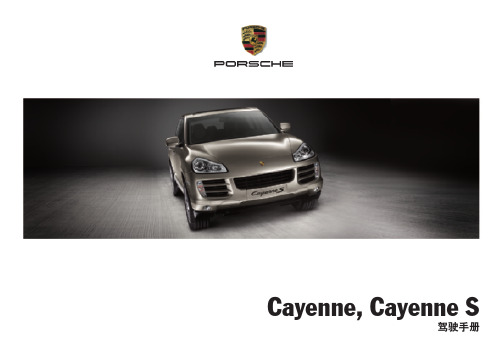
目录Leabharlann 概览图示........................................... 4
驾驶员侧驾驶舱............................................ 5 方向盘和仪表组............................................ 6 前部中控台................................................... 7
目录 1
显示剩余燃油可达里程 ............................. 115 显示轮胎气压 ........................................... 115 显示罗盘 .................................................. 115 显示导航信息 ........................................... 115 通过多功能显示器使用电话 ...................... 116 在多功能显示器上设置限速 ...................... 117 显示警告信息 ........................................... 118 显示车身水平高度控制系统的状态 ............ 119 显示锁止机构 / 越野档的状态 ................... 119 显示平均油耗 ........................................... 120 设置轮胎气压监控 .................................... 120 在多功能显示器上关闭车内监控和 倾斜传感器............................................... 129 车门镜同步调节........................................ 129 改变车辆解锁和锁止设置.......................... 130 开启 / 关闭日间行车灯 ............................. 132 设置照明延迟关闭 .................................... 133 设置时钟 .................................................. 133 设置罗盘 .................................................. 134 更改显示语言 ........................................... 135 更改显示单位 ........................................... 135 将显示复位到出厂设置 ............................. 135 警告信息综述 ........................................... 136
保时捷Cayenne驾驶手册说明书

Cayenne、Cayenne S、Cayenne GTS、Cayenne S Transsyberia驾驶手册Porsche、保时捷盾徽、Cayenne、PCCB、PCM、PSM、Transsyberia、Tiptronic和精装配件均为Dr. Ing. h.c. F. Porsche AG 的注册商标。
中国印刷。
未经 Dr. Ing. h.c. F. Porsche AG 书面授权,不得再版、摘录或复印本手册。
© Dr. Ing. h.c. F. Porsche AGPorscheplatz 1D-70435 Stuttgart行车参考文件请将此文件随车携带,并在转售车辆时移交给新的车主。
建议如果您对您的车辆或本行车参考文件有任何疑问、建议或想法,请与我们联系:Dr. Ing. h.c. F. Porsche AGVertrieb Customer RelationsPorschestraße 15–1971634 Ludwigsburg 设备由于我们对车辆的创新与开发从未停止,因此您车辆的实际设备与规格可能与本驾驶手册中图示或描述的内容有所不同。
在我们出售的车辆中,某些设备可能属于选装件,或者根据法律要求或国家的不同而有所改变。
您的保时捷中心将乐于为您提供这些装备的加装服务。
如果您的保时捷安装了任何本手册中未描述的装备,为您服务的保时捷中心将乐于提供相关的正确操作及保养建议。
由于各个国家的法律要求不同,您车辆上的装备可能与本驾驶手册中的描述略有不同。
在中国市场仅供应 Cayenne 汽油版车型。
WKD 948 093 1002/09354目录概览图示 (4)驾驶员侧驾驶室 (5)方向盘和仪表组 (6)前部中控台 (7)开启和锁止 (8)概述 – 从车外开启和锁止 (9)从车外开启和锁止 (10)从车内开启和锁止 (18)开启和关闭发动机盖 (20)开启和关闭时的故障 (21)关于车匙和中控锁系统的注意事项 (23)座椅、后视镜和方向盘 (25)前排座椅 (26)带位置记忆功能的前排座椅 (27)便捷出入功能 (29)座椅头枕 (30)灭火器 (31)前排和后排座椅加热 (31)安全带 (33)安全气囊系统 (36)儿童约束系统 (38)车门镜 (44)内后视镜 (46)自动防眩目内后视镜 (46)方向盘 (47)加热式方向盘 (47)方向盘调节 (48)多功能方向盘..............................................49遮阳板 (51)化妆镜 (51)后侧车窗遮阳卷帘 (51)空调、辅助加热器和后窗加热系统 (52)开启盖罩 (53)空调系统综述 (53)适用于每一款空调系统 (54)概述 – 手动控制空调系统 (55)手动控制空调系统 (56)概述 – 自动控制2 区域空调系统 (58)自动控制 2 区域空调系统 (59)概述 – 自动控制 4 区域空调系统,前控制面板 (62)概述 – 自动控制 4 区域空调系统,后控制面板 (63)自动控制 4 区域空调系统 (64)出风口 (68)加热式后窗 (69)辅助加热器/附加加热器 (70)车窗和滑动式天窗 (75)电动车窗 (76)概述 – 滑动/举升式天窗 (79)滑动/举升式天窗 (80)概述 – 全景式天窗系统 (84)全景式天窗系统 (85)全景式天窗系统的紧急操作 (89)车灯、转向指示灯和挡风玻璃雨刷器 (91)灯光开关 (92)仪表板照明 (93)手动大灯光束调节 (94)自动大灯光束调节 (94)转向指示灯/远光灯/大灯远近光操纵杆 (95)危险警示灯 (95)车内照明灯 (96)舒适照明 (97)回家照明功能(延迟关闭) (98)门控灯 (98)概述 – 挡风玻璃雨刷器 (99)挡风玻璃雨刷器/清洗器操纵杆 (100)目录1多功能显示器和仪表 (103)汽油发动机车型的仪表板 (104)柴油发动机车型的仪表板 (106)机油温度表 (108)转速表 (108)时钟 (108)燃油表 (108)车速表 (108)里程显示 (108)电位计 (109)冷却系统 (109)Cayenne(V6)和Cayenne Diesel的智能保养电脑 (110)排放控制 (111)柴油发动机故障 (111)操作仪表板上的多功能显示器 (112)打开主菜单 (113)操作示例:显示平均油耗 (113)显示/复位平均车速 (115)显示剩余燃油可达里程 (115)显示轮胎气压 (115)显示罗盘 (115)通过多功能显示器使用电话 (116)在多功能显示器上设置限速 (117)显示警告信息 (118)显示车身水平高度控制系统的状态 (119)显示锁止系统/越野档的状态 (119)显示平均油耗 (120)设置轮胎气压监控 (120)在多功能显示器上关闭车内监控和倾斜传感器 (129)车门镜同步调节 (129)改变车辆解锁和锁止设置 (130)开启/关闭日间行车灯..............................132设置照明延迟关闭. (133)设置时钟 (133)设置罗盘 (134)更改显示语言 (135)更改显示单位 (135)将显示复位到出厂设置 (135)警告信息综述 (136)驾驶和行驶安全 (144)开车之前 (145)磨合技巧 (145)回收利用 (145)技术改造 (146)尾管 (146)Porsche 陶瓷复合制动系统(PCCB) (146)点火锁/转向锁 (147)起动和关闭发动机 (149)手机和双向无线电通讯 (150)Porsche 通讯管理系统(PCM) (150)收音机 (150)iPod、USB 和 AUX 接口 (151)停车制动器 (152)脚制动器 (152)巡航定速控制 (154)手动变速箱、离合器 (156)Tiptronic S (157)选档杆位置 (158)用于公路和越野驾驶的驾驶程序 (165)变速箱和底盘控制系统 (169)带有车身水平高度控制和高度调节功能的气动悬挂系统 (179)Porsche 主动悬挂管理系统(PASM) (182)Porsche 动态底盘控制(PDCC) (183)越野驾驶 (184)用于越野驾驶的行驶系统 (185)上坡道驾驶 (186)下坡道驾驶 (187)涉水驾驶 (188)跨越障碍物 (189)行李厢、装载区和储物空间 (191)向前折叠后排座椅及恢复到竖直位置 (192)装载区 (195)装载区管理系统 (196)装载 (199)行李厢盖 (200)行李安全网兜 (201)滑雪包 (203)车顶运输系统 (205)Cayenne S Transsyberia的车顶越野大灯 (206)储物空间 (207)杯座 (210)烟灰缸,前排 (212)烟灰缸,后排 (212)点烟器 (213)拖车钩 (214)拖车钩 (215)带有可拆卸式球形接头的拖车钩 (217)电动可伸出拖车钩 (222)驻车 (224)停车辅助系统 (225)作为停车辅助功能向下转动后视镜玻璃 (229)车库开门装置 (229)2目录防盗警报系统和防盗保护 (232)防盗警报系统 (233)防盗装置 (235)转向柱锁 (235)防盗保护 (235)保养和车辆养护 (236)保养注意事项 (237)检查机油油位 (238)添加机油 (239)检查冷却液液位并添加冷却液 (241)检查制动液液位并更换制动液 (243)洗涤液的添加 (244)更换空气滤清器 (245)更换微粒滤清器 (245)动力转向 (245)雨刷器刮片 (247)排放控制系统,汽油发动机 (249)燃油罐 (249)柴油微粒滤清器 (250)燃油和加油 (251)车辆养护说明 (253)小修 (261)小修注意事项 (262)轮胎和车轮 (263)千斤顶 (269)工具包 (269)充气泵 (270)厚垫片 (270)车轮螺栓 (271)维修漏气轮胎 (272)轮胎充气(不带车身水平高度控制系统的车辆)........282轮胎充气(带车身水平高度控制系统的车辆) (283)备用轮胎 (285)电气系统 (288)蓄电池 (297)更换遥控器电池 (300)外部电源,跨接起动 (301)更换灯泡 (303)大灯 (304)尾灯 (313)牌照灯 (315)大灯调整 (316)将左侧通行改为右侧通行时的大灯 (316)灯泡规格表 (317)牵引和牵引起动 (318)轮胎气压和技术数据 (322)车辆识别数据 (323)发动机技术数据 (324)耗油量和排放 (325)轮胎、车轮、轮距 (326)冷态(20°C)下的轮胎气压 (330)重量 (332)离地间隙 (333)容量 (335)尺寸 (336)行驶性能 (337)索引 (338)目录3概览图示驾驶员侧驾驶室 (5)方向盘和仪表组 (6)前部中控台 (7)4概览图示概览图示5驾驶员侧驾驶室1.电动车窗请参见第76页。
沃尔沃汽车手册说明书
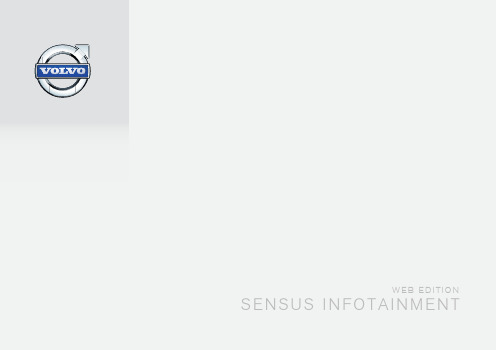
硬盘驱动器 进寻请请远..................... 旧拨
媒体播 器 - 兼容文件格式............ 旧择
通过 致U下/U分B 输入 接外部音源......... 旧只
通过 致U下/U分B 输入 接外部音源......... 旧叫
使用中 的按钮和 制或方向盘 侧的键 盘, 启动或解除*功能和 行许多ď 的
置
按č MY重台AR,显示Đ车 驾驶和 制有关的
所有 定,例如 Cit本 分且f优t本 和警 自
动风扇转
定时钟等
中 中的 制面
示仅用作示意 - 功能的
数量和按钮的 置 选定的 备和具体 场而
异 航 * - 寻AV , 参 阅 ĕ 门 的 附 录
分优n账u账 航系统 音响和媒体 - RADI导 MEDIA TEL*,
参阅 附录的相关章节
功 能 置 - MY重 台AR , 参 阅 销同 C致R 进 码古详远
}}
* 选配件/附件的更多信息, 查看 言
只
01重 言
口古
车 互联网 接 -
*,
参阅
古
附录
车 中的电子版 车 手
选 č角的信息符 ,获 电子 车Ľ手册
®
03B速u优tooth 免提电话 - 音量 置........ 拨拨
电话簿............................... 拨择 电话簿 - 快 搜索联系人.............. 拨择 电话簿 - 中 Č的 符表键盘........ 拨择 电话簿 - 搜索联系人.................. 拨只 语音识别............................. 拨只 语音识别的语言选 ................... 拨叫 语音识别的帮助功能................... 拨9 语音识别 - 置...................... 拨9 语音识别 - 语音指 .................. 择口 语音识别 - 快 指 .................. 择口 语音识别 - 移动电话.................. 择口 语音识别 - 收音机.................... 择古 语音识别 - 多媒体.................... 择古 联网车 ............................. 择该 车 调制解调器 *..................... 择旧
汽车驾驶手册范本
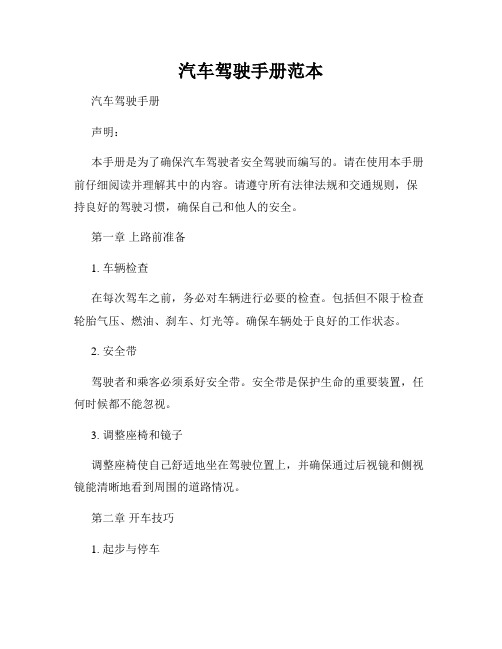
汽车驾驶手册范本汽车驾驶手册声明:本手册是为了确保汽车驾驶者安全驾驶而编写的。
请在使用本手册前仔细阅读并理解其中的内容。
请遵守所有法律法规和交通规则,保持良好的驾驶习惯,确保自己和他人的安全。
第一章上路前准备1. 车辆检查在每次驾车之前,务必对车辆进行必要的检查。
包括但不限于检查轮胎气压、燃油、刹车、灯光等。
确保车辆处于良好的工作状态。
2. 安全带驾驶者和乘客必须系好安全带。
安全带是保护生命的重要装置,任何时候都不能忽视。
3. 调整座椅和镜子调整座椅使自己舒适地坐在驾驶位置上,并确保通过后视镜和侧视镜能清晰地看到周围的道路情况。
第二章开车技巧1. 起步与停车车辆起步时应缓慢松离离合器,控制好加速踏板和刹车踏板的力度。
停车时应提前减速,平稳踩下刹车并挂入合适的档位。
2. 转弯在转弯时,提前减速并打开转向灯。
注意观察交叉路口和行人,保持车辆匀速通过弯道。
3. 超车在超车时,要选择合适的时机和位置。
提前打开转向灯,并观察后方车辆情况。
在确保安全的情况下迅速超越前车,并及时回到原车道。
4. 保持车距行车时必须保持足够的安全车距。
根据道路和车辆状况,确保能在紧急情况下安全刹车。
第三章高速公路驾驶1. 加入与退出高速公路根据交通信号或标志指示,提前打开转向灯,按照规定的车速加入或退出高速公路,并注意周围车辆的情况。
2. 高速公路行驶在高速公路上,要保持车辆稳定,并保持适当的车速。
不可超速行驶,同时要保持与周围车辆的安全车距。
3. 超车与变道在高速公路上超车时,要提前打开转向灯,确保安全的情况下迅速超越前车。
变道时也要提前打开转向灯,并注意观察后方车辆情况。
第四章特殊路况处理1. 雨天行驶在雨天行驶时,需减速并保持安全车距。
开启雨刷器和车灯,确保能清晰地看到前方和周围的道路情况。
2. 夜间行驶夜间行驶时要开启车灯,并提前减速。
保持集中注意力,注意观察道路前方和周围的情况。
3. 通过路口通过路口时,要注意观察交通信号灯和行人,按照规定的车速和次序通过。
汽车驾驶手册

汽车驾驶手册驾驶汽车是一项需要掌握一定技能和知识的活动。
为了确保驾驶者和乘客的安全,了解汽车的运行原理、交通规则和驾驶技巧是至关重要的。
本文将为您介绍一份全面的汽车驾驶手册,以帮助您成为一位安全、合格的驾驶员。
一、汽车基本知识1.1 汽车构造了解汽车的基本构造对驾驶者至关重要。
汽车由发动机、传动系统、悬挂系统、制动系统等多个部件组成。
每个部件都承担着不同的功能,它们的正常工作保证了汽车的安全和可靠性。
1.2 汽车维护与保养为了确保汽车的正常运行,定期进行维护和保养至关重要。
常见的维护包括更换机油、检查轮胎气压、保持车身清洁等。
保养可以延长汽车的使用寿命,并减少故障的发生。
二、交通规则2.1 交通标志与标线交通标志和标线是道路上的指示标志,用于指示驾驶者应该如何行驶和注意什么。
不同的标志和标线代表着不同的含义,掌握并遵守这些规则可以提高驾驶的安全性。
2.2 交通信号灯交通信号灯是交通管理的重要组成部分,驾驶者通过交通信号灯的指示掌握交通状况和行驶规划。
熟悉交通信号灯的颜色和含义,并在行驶过程中正确遵守信号灯规定,是每位驾驶者的基本要求。
2.3 优先权规则在道路上行驶时,了解优先权规则可以保证行车的顺利进行。
根据不同交通情况的优先权规则,驾驶者需要给予其他车辆或行人相应的让行权利,从而避免交通事故的发生。
三、驾驶技巧3.1 起步与停车掌握正确的起步和停车技巧对于驾驶者来说至关重要。
起步时需要正确操作离合器、油门和制动器,平稳起步;停车时需要选择合适的位置、正确使用制动器,并进行安全停车。
3.2 转弯与变道转弯和变道是驾驶中常见的动作,但也是容易发生事故的环节。
在转弯和变道时,驾驶者需要提前观察交通状况,正确使用转向灯并与其他车辆保持安全距离,确保操作平稳、安全。
3.3 安全行车与超车安全行车和超车是驾驶者应该具备的基本技能。
在行驶过程中,驾驶者需要保持适当的车速、保持安全距离,并随时观察道路状况。
超车时,需要选择合适的时机,并通过正确的方式进行超车操作。
汽车驾驶技巧手册

汽车驾驶技巧手册第一章:基础知识 (2)1.1 驾驶前的准备 (2)1.1.1 检查车辆状况 (2)1.1.2 调整座椅和后视镜 (2)1.1.3 确认安全带 (3)1.1.4 检查仪表盘 (3)1.2 驾驶姿势与操作规范 (3)1.2.1 驾驶姿势 (3)1.2.2 操作规范 (3)第二章:起步与停车 (3)2.1 起步操作 (3)2.2 停车操作 (4)2.3 倒车技巧 (4)2.4 平行停车与斜线停车 (4)第三章:方向盘控制 (5)3.1 方向盘握法 (5)3.2 转向操作 (5)3.3 转弯技巧 (5)3.4 转向回正 (5)第四章:油门与刹车控制 (6)4.1 油门控制 (6)4.2 刹车控制 (6)4.3 紧急刹车 (6)4.4 节油技巧 (7)第五章:行驶技巧 (7)5.1 直行技巧 (7)5.2 超车与让道 (7)5.3 上下坡行驶 (8)5.4 弯道行驶 (8)第六章:夜间行驶 (8)6.1 夜间驾驶注意事项 (8)6.2 夜间行驶技巧 (9)6.3 夜间会车与超车 (9)6.4 夜间道路识别 (9)第七章:恶劣天气行驶 (10)7.1 雨天行驶 (10)7.2 雾天行驶 (10)7.3 雪天行驶 (10)7.4 沙尘天气行驶 (11)第八章:安全行车 (11)8.1 安全行车原则 (11)8.2 安全距离 (11)8.3 预防交通 (12)8.4 紧急情况处理 (12)第九章:故障处理 (12)9.1 常见故障诊断 (12)9.1.1 发动机故障诊断 (12)9.1.2 变速器故障诊断 (13)9.1.3 制动系统故障诊断 (13)9.2 紧急故障处理 (13)9.2.1 发动机故障处理 (13)9.2.2 变速器故障处理 (13)9.2.3 制动系统故障处理 (13)9.3 应急救援 (13)9.3.1 车辆故障时的应急处理 (13)9.3.2 遇到自然灾害时的应急处理 (14)9.4 驾驶员自救 (14)9.4.1 遇到时的自救方法 (14)9.4.2 遇到突发疾病时的自救方法 (14)第十章:保养与维护 (14)10.1 日常保养 (14)10.2 定期检查 (14)10.3 驾驶员自我检查 (15)10.4 车辆维护与保养 (15)第一章:基础知识1.1 驾驶前的准备在正式驾驶前,进行充分的准备工作是保证行车安全的关键。
驾驶员手册驾驶基础知识
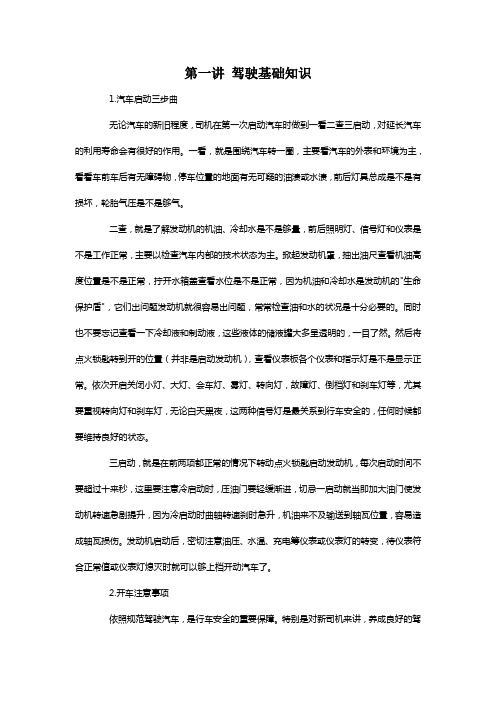
第一讲驾驶基础知识1.汽车启动三步曲无论汽车的新旧程度,司机在第一次启动汽车时做到一看二查三启动,对延长汽车的利用寿命会有很好的作用。
一看,就是围绕汽车转一圈,主要看汽车的外表和环境为主,看看车前车后有无障碍物,停车位置的地面有无可疑的油渍或水渍,前后灯具总成是不是有损坏,轮胎气压是不是够气。
二查,就是了解发动机的机油、冷却水是不是够量,前后照明灯、信号灯和仪表是不是工作正常,主要以检查汽车内部的技术状态为主。
掀起发动机罩,抽出油尺查看机油高度位置是不是正常,拧开水箱盖查看水位是不是正常,因为机油和冷却水是发动机的"生命保护盾",它们出问题发动机就很容易出问题,常常检查油和水的状况是十分必要的。
同时也不要忘记查看一下冷却液和制动液,这些液体的储液罐大多呈透明的,一目了然。
然后将点火锁匙转到开的位置(并非是启动发动机),查看仪表板各个仪表和指示灯是不是显示正常。
依次开启关闭小灯、大灯、会车灯、雾灯、转向灯,故障灯、倒档灯和刹车灯等,尤其要重视转向灯和刹车灯,无论白天黑夜,这两种信号灯是最关系到行车安全的,任何时候都要维持良好的状态。
三启动,就是在前两项都正常的情况下转动点火锁匙启动发动机,每次启动时间不要超过十来秒,这里要注意冷启动时,压油门要轻缓渐进,切忌一启动就当即加大油门使发动机转速急剧提升,因为冷启动时曲轴转速刹时急升,机油来不及输送到轴瓦位置,容易造成轴瓦损伤。
发动机启动后,密切注意油压、水温、充电筹仪表或仪表灯的转变,待仪表符合正常值或仪表灯熄灭时就可以够上档开动汽车了。
2.开车注意事项依照规范驾驶汽车,是行车安全的重要保障。
特别是对新司机来讲,养成良好的驾驶习惯,可终生受益。
开车时,你有以下这些坏习惯吗?转向掏轮:汽车拐弯时,左手或右手反握方向盘,这样做虽然使转向省力,但遇汽车颠时,极易将手腕打伤,特别是回轮时,极易将手腕打伤,特别是回轮速度慢,极易发生交通事故。
汽车驾驶图解及教程
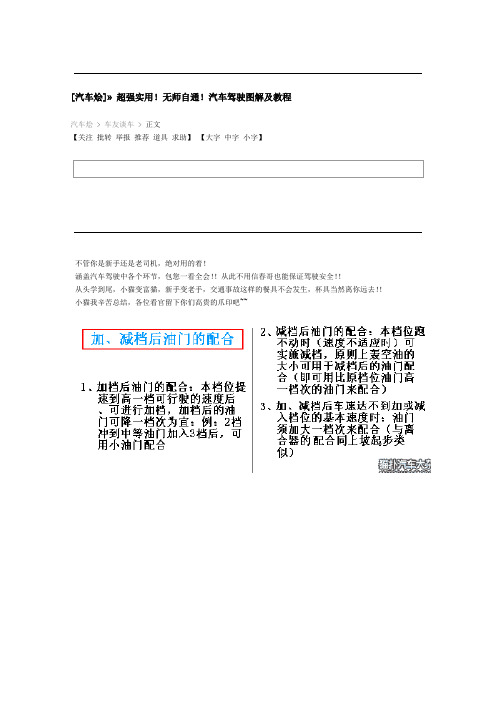
[汽车烩]» 超强实用!无师自通!汽车驾驶图解及教程汽车烩 > 车友谈车 > 正文【关注批转举报推荐道具求助】【大字中字小字】不管你是新手还是老司机,绝对用的着!涵盖汽车驾驶中各个环节,包您一看全会!!从此不用信春哥也能保证驾驶安全!!从头学到尾,小猫变富猫,新手变老手,交通事故这样的餐具不会发生,杯具当然离你远去!!小猫我辛苦总结,各位看官留下你们高贵的爪印吧~~做人要厚道,转载请注明来自猫扑()(发帖时间:2009-11-25 11:33:18)--- IEEI传呼道具博客 | 【回复】【楼主】(1):--- IEEI传呼道具博客 | 【回复】【楼主】(2):--- IEEI传呼道具博客 | 【回复】【楼主】(3):--- IEEI传呼道具博客 | 【回复】【楼主】(4):--- IEEI传呼道具博客 | 【回复】【楼主】(5):--- IEEI传呼道具博客 | 【回复】【楼主】(6):--- IEEI传呼道具博客 | 【回复】猫(7):图文并茂啊--- 情感季风传呼道具博客 | 【回复】扑(8):强人!!!膜拜--- szhongshun 传呼道具博客 | 【回复】猫(9):前十、不过俺是老司机了--- 干死小鬼子传呼道具博客 | 【回复】扑(10):恩辛苦总结--- 谁了此局传呼道具博客 | 【回复】猫(11):祖国的驾证是不是很难拿到手啊!我花了好多钱为了需要加考了A 最郁闷的是A照还分A1 A2 A 3 最后A照在公交公司加考的还不能驾驶A1的车辆可笑--- 广丰有美女传呼道具博客 | 【回复】扑(12):神人内.膜拜.--- 假流氓真仗义传呼道具博客 | 【回复】猫(13):还没学车,留名日后参考--- 大卫贝克老鼠传呼道具博客 | 【回复】扑(14):啊收藏--- fo198767 传呼道具博客 | 【回复】猫(15):好贴--- 感觉那么真传呼道具博客 | 【回复】扑(16):自学成才!--- 盗我号者木JJ.传呼道具博客 | 【回复】猫(17):看不懂...--- 在猫扑上进化成流氓传呼道具博客 | 【回复】扑(18):楼上顶贴的被逼的吧,你们能看懂??--- 在猫扑上进化成流氓传呼道具博客 | 【回复】猫(19):读图时代,强帖留名!--- 漂流时间河传呼道具博客 | 【回复】扑(20):杯具~看得我不敢学了~--- 无聊的时候就上猫扑网传呼道具博客 | 【回复】猫(21):没开过车的人看你的这个讲解,永远不会开车的。
Macan驾驶手册说明书

Macan驾驶手册WK D95B 08 93 16M a c a nw Porsche 、保时捷盾徽、Macan 、PCCB 、PCM 、PDK 、PSM 、PTM 和Tequipment 都是 Dr. Ing. h.c.F. Porsche AG (保时捷股份公司)的注册商标。
未经 Dr. Ing. h.c. F. Porsche AG (保时捷股份公司)书面授权,不得以任何形式再版、摘录或复印本手册。
© Dr. Ing. h.c. F. Porsche AG (保时捷股份公司)版权所有Porscheplatz 170435 Stuttgart行车参考文件请务必将此参考文件随车携带,并在转售车辆时移交给新车主。
建议如果对车辆或本行车参考文件有任何疑问、建议或想法,请致函以下地址:Dr. Ing. h.c. F. Porsche AGVertrieb Customer RelationsPorscheplatz 170435 Stuttgart装备由于保时捷对车辆的创新与开发从未停止,因此您的车辆的实际装备与规格可能与本手册中图示或描述的内容有所不同。
在我们出售的车辆中,某些装备可能属于选装配置,或者因法律要求或国家/地区的不同而有所不同。
您的保时捷保时捷中心将乐于为您提供这些装备的加装服务。
如果您的保时捷安装了任何本手册中未描述的装备,为您服务的保时捷中心将乐于提供相关的正确操作及保养建议。
由于各个国家/地区的法律要求不同,您车辆上的装备可能与本《驾驶手册》中的描述略有不同。
安全气囊警告标签如果乘客侧座椅上装有儿童保护系统,则存在乘客侧安全气囊被触发导致严重伤害甚至致命的风险。
f 切勿在启用了前排安全气囊的乘客侧座椅上使用面朝后的儿童保护系统,这样做可能导致儿童受伤甚至死亡。
请参阅第41 页的“儿童保护系统”章节。
《驾驶手册》中的安全指南本《驾驶手册》中包含各种不同类型的安全指南。
未遵守“危险”中的安全指南会导致严重或致命的人身伤害。
车辆驾驶操作手册
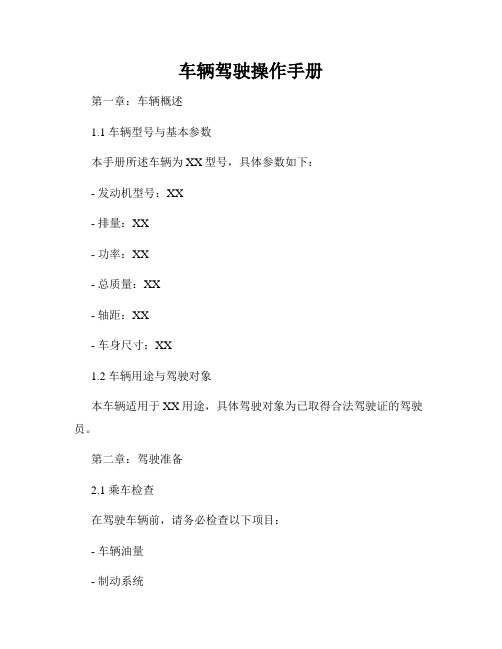
车辆驾驶操作手册第一章:车辆概述1.1 车辆型号与基本参数本手册所述车辆为XX型号,具体参数如下:- 发动机型号:XX- 排量:XX- 功率:XX- 总质量:XX- 轴距:XX- 车身尺寸:XX1.2 车辆用途与驾驶对象本车辆适用于XX用途,具体驾驶对象为已取得合法驾驶证的驾驶员。
第二章:驾驶准备2.1 乘车检查在驾驶车辆前,请务必检查以下项目:- 车辆油量- 制动系统- 轮胎气压- 外部灯光系统2.2 安全带使用在行车过程中,驾驶员和乘客应始终系好安全带,确保乘车安全。
2.3 调整座椅与镜子驾驶前,请调整座椅与镜子,确保舒适度和视野,并避免对驾驶操作造成干扰。
第三章:车辆启动与停止3.1 引擎启动- 将钥匙插入点火锁孔- 轻轻转动钥匙,启动发动机- 听到发动机启动声音后,松开钥匙3.2 停车与熄火- 缓慢松开油门踏板,减速至停车- 松开离合器,将档位置于空档(手动变速器)或P档(自动变速器)- 拉起手刹- 熄灭所有车辆外部灯光,关闭电源第四章:行车操作4.1 变速器操作(手动变速器)- 按下离合器踏板- 将档位从空档转移到目标挡位- 松开离合器踏板,同时轻踩加速踏板4.2 刹车操作- 踩下制动踏板,适度施加制动力度- 在必要时,使用紧急制动器(手刹)4.3 方向盘操作- 轻轻握住方向盘,保持双手握把- 转动方向盘时,避免猛扭或过度转动4.4 灯光操作- 进行夜间行车或能见度低的条件下,请打开前灯- 在转弯或变更车道前,请使用转向灯提前提示其他车辆第五章:应急情况处理5.1 汽车事故- 在发生事故后,先确保自身安全,尽可能将车辆移到安全地带- 与其他当事人协商交换车辆信息与保险信息- 如有人员受伤,及时拨打报警电话并寻求医疗帮助5.2 外部紧急情况- 遇到自然灾害、交通管制或其他不可预测情况时,请听从交通管理人员指示,并及时调整行车计划第六章:维护与保养6.1 检查液位请定期检查以下液体的液位,并按照车辆使用手册中的要求进行添加或更换:- 发动机机油- 制动液- 冷却液- 雨刷器液6.2 保养周期根据车辆使用手册中的要求,定期进行车辆保养,包括机油更换、滤芯更换等项目。
汽车驾驶手册说明书
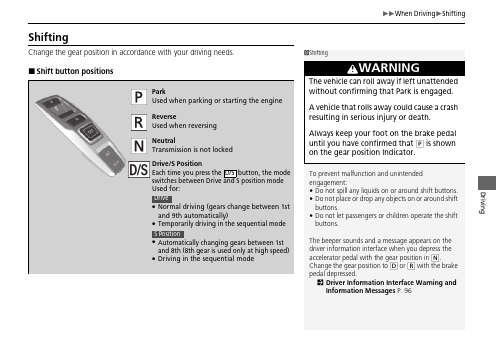
DrivingShiftingChange the gear position in accordance with your driving needs.■Shift button positions1ShiftingTo prevent malfunction and unintended engagement:•Do not spill any liquids on or around shift buttons.•Do not place or drop any objects on or around shift buttons.•Do not let passengers or children operate the shift buttons.The beeper sounds and a message appears on the driver information interface when you depress the accelerator pedal with the gear position in N .Change the gear position to D or R with the brake pedal depressed.2Driver Information Interface Warning and Information Messages P.963WARNINGThe vehicle can roll away if left unattended without confirming that Park is engaged.A vehicle that rolls away could cause a crash resulting in serious injury or death.Always keep your foot on the brake pedal until you have confirmed that P is shown on the gear position Indicator.ParkUsed when parking or starting the engine ReverseUsed when reversing NeutralTransmission is not lockedDrive/S PositionEach time you press the button, the mode switches between Drive and S position mode Used for:●Normal driving (gears change between 1st and 9th automatically)●Temporarily driving in the sequential mode ●Automatically changing gears between 1st and 8th (8th gear is used only at high speed)●Driving in the sequential modeD/S DriveS PositionDriving■P (parking) buttonPark your vehicle in a safe place with the power mode in ON, then apply the brakes and press the P button to put the transmission in Park.The indicators on the sides of the P button come on.1ShiftingWhen shifting gears in extremely low temperatures (−22°F/−30°C), there may be a short delay before the shift is indicated in the display. Always confirm you are in the correct gear before driving.P ButtonDriving■Shift Operation1Shift OperationNOTICEWhen you change D to R and vice versa, depress the brake pedal to come to a complete stop, then select the intended gear position while maintaining brake pressure.Use the gear position indicator and the shift button indicator to check the gear position before selecting a shift button.If the indicator of the currently selected gear position, or all the gear position indicators are blinking simultaneously, there is a problem with the transmission.Avoid sudden acceleration and have the transmission checked by a dealer as soon as possible.The fuel supply may be cut off if you drive at engine speeds in or over the tachometer red zone (engine speed limit). If this happens, you may experience a slight jolt.When the engine speed is increased while thetransmission is in N , P or R , the fuel supply may be cut off even without the engine speed entering the tachometer red zone.From the audio/information screen, you can choose to have the system activate a beeper when you change to R .2Customized Features P.327Driving In freezing or sub-freezing conditions, the electronic gear selector response may beslow.Always depress the brake pedal before changing the gear position to P, andconfirm that P is shown on the gear position indicator before releasing the brake.■When opening the driver’s doorIf you open the driver’s door under the following conditions, the gear positionautomatically changes to P.•The vehicle is stationary with the engine running, or moving at 1 mph (2 km/h) orslower.•The transmission is in other than P.•You have unfastened the driver side seat belt.u If you manually change the gear position from P with the brake pedaldepressed, the gear position will automatically return to P once you releasethe brake pedal.■When turning off the power modeIf you turn the engine off while the vehicle is stationary, and the transmission is inother than P, the gear position automatically changes to P.1When opening the driver’s doorYou should always select P before opening thedriver’s door.Make sure to park the vehicle in a safe place.2When Stopped P.480If you want to drive the vehicle after the gear positionhas automatically changed to P under the describedconditions, close the door, fasten the seat belt,depress the brake pedal, then change the gearposition.If you leave the vehicle, turn off the engine and lockthe doors.Driving■If you want to keep the transmission in N position [car wash mode]With the engine running:1.Press and hold the brake pedal.2.Select N , then release the button to display (Neutral) N hold mode on the driver information interface.3.Press and hold N again for two seconds.u This puts the vehicle in car wash mode which must be used when your vehicle is pulled through a conveyor type automatic car wash where you or an attendant do not remain in the vehicle.If the ENGINE START/STOP button is pressed after car wash mode has been activated, the power mode will change to ACCESSORY and a message will be displayed on the driver information interface.u For 15 minutes the gear position remains in N with the power mode inACCESSORY. After that, the position automatically changes to P and the power mode changes to OFF.u Manually changing to P cancels ACCESSORY mode. The P indicator comes on and the power mode changes to OFF. You must always shift to P when car wash mode is no longer needed.1If you want to keep the transmission in N position [car wash mode]To keep the vehicle N position, you can also follow this procedure:While the power mode is on, select N , and then within five seconds, press the ENGINE START/STOP button.Note that the transmission may not stay in N position while any of the following indicators is on:•Transmission system indicator.•Malfunction indicator lamp.•Charging system indicator.Driving ■Restrictions on selecting a gear positionYou cannot select a gear position under certain circumstances that may lead to a crash.When thetransmission is in:1.Under these circumstances:2.If you try to change tothe following:3. The gear positionremains in/changes to:How to change thegear position PThe brake pedal is not depressed.Other gear positionPThe accelerator pedal isdepressed.NThe vehicle is moving at lowspeed without the brake pedaldepressed.NThe vehicle is moving at lowspeed with the accelerator pedaldepressed.N D S The vehicle is moving forward.RR N The vehicle is moving backward.D, SR N D S The vehicle is moving.PDrivingUse the paddle shifters to change between 1st and 9th gears without removing your hands from the steering wheel. The transmission will switch to the sequential mode.■When the transmission is in D :The vehicle will go into the sequential mode momentarily, and the sequential mode gear selection indicator will come on.Once you start traveling at a constant speed, the sequential mode will automatically switch off, and the sequential mode gear selection indicator will go off.Hold the + paddle shifter for two seconds or push button to return to normal drive.■When the transmission is in SThe vehicle will go into the sequential mode, and the M (sequential mode) indicator and sequential mode gear selection indicator will come on.If the vehicle speed increases and the engine speed reaches near the tachometer red zone, the transmission automatically shifts up to the next gear.You can cancel this mode by holding the + paddle shifter for two seconds or push button. When the sequential mode is canceled, the sequential mode indicator and sequential mode gear selection indicator go off.■Sequential ModeD/S D/SDriving■Sequential Mode Operation1Sequential Mode OperationEach paddle shift operation makes a single gear change.To change gears continuously, release the paddle shifter before pulling it again for the next gear.If the sequential mode gear selection indicator blinks when you try to shift up or down, this means your vehicle speed is not in its allowable gear range or the protection of transmission system is necessary.Slightly accelerate to shift up and decelerate to shift down while the indicator is blinking.Sequential Mode Gear Selection IndicatorDownshifting when pulling the paddle shifter.(Changes to a lower gear)Upshifting when pulling the paddle shifter.(Changes to a higher gear)。
汽车驾驶手册.pdf_1702097098.2017741说明书
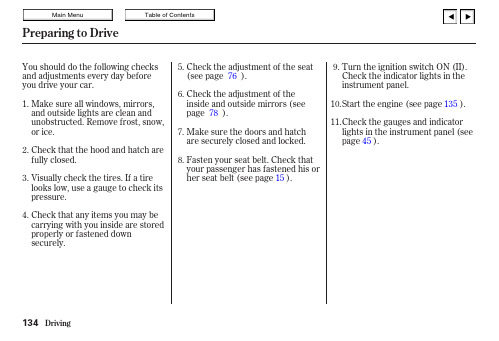
Make sure all windows,mirrors,and outside lights are clean and unobstructed.Remove frost,snow,or ice.Check the adjustment of the seat (see page ).Check the adjustment of the inside and outside mirrors (see page ).Turn the ignition switch ON (II).Check the indicator lights in the instrument panel.Start the engine (see page ).Check the gauges and indicator lights in the instrument panel (see page ).Check that any items you may be carrying with you inside are stored properly or fastened down securely.Visually check the tires.If a tire looks low,use a gauge to check its pressure.Check that the hood and hatch are fully closed.You should do the following checks and adjustments every day before you drive your car.Fasten your seat belt.Check that your passenger has fastened his or her seat belt (see page ).Make sure the doors and hatch are securely closed and locked.1.2.3.4. 5.6.7.8.9.10.11.45767815135Preparing to Drive134Apply the parking brake.In cold weather,turn off all electrical accessories to reduce the drain on the battery.Push the clutch pedal down all the way.START (III)does notfunction unless the clutch pedal is depressed.Without touching the accelerator pedal,turn the ignition key to the START (III)position.If the engine does not start right away,do not hold the key in START (III)for more than 15seconds at a time.Pause for at least 10seconds before trying again.If the engine does not start within 15seconds,or starts but stallsright away,repeat step 4with the accelerator pedal pressed half-way down.If the engine starts,release pressure on the accelerator pedal so the engine does not race.If the engine still does not start,press the accelerator pedal all the way down and hold it there while starting in order to clear flooding.As before,keep the ignition key in the START (III)position for no more than 15seconds.Return to step 5if the engine does not start.If it starts,lift your foot off the accelerator pedal so the engine does not race.An engine is harder to start in cold weather.The thinner air found at high altitude above 8,000feet(2,400meters)adds to the e the following procedure:Turn off all electrical accessories to reduce the drain on the battery.Push the accelerator pedal half-way to the floor and hold it there while starting the engine.Do not hold the ignition key in START (III)for more than 15seconds.When the engine starts,release the accelerator pedal gradually as the engine speeds up and smooths out.If the engine fails to start in step 2,push the accelerator pedal to the floor and hold it there while you try to start the engine for no more than 15seconds.If the engine does not start,return to step 2.Make sure the shift lever is in Park.Press on the brake pedal.1.2.3.4.5. 6. 1.2.3.Manual Transmission:Automatic Transmission (CVT):Starting the EngineStarting in Cold Weather at High Altitude (Above 8,000feet/2,400meters)135The manual transmission is syn-chronized in all forward gears for smooth operation.It has a lockout so you cannot shift directly from Fifth to Reverse.When shifting up ordown,make sure you push the clutch pedal down all the way,shift to the next gear,and let the pedal upgradually.When you are not shifting,do not rest your foot on the clutch pedal.This can cause your clutch to wear out faster.Come to a full stop before you shift into Reverse.You can damage the transmission by trying to shift into Reverse with the car moving.Push down the clutch pedal,and pause for a few seconds before shifting into Reverse,or shift into one of the forward gears for a moment.This stops the gears so they won’t ‘‘grind.’’When slowing down,you can get extra braking from the engine by shifting to a lower gear.This extra braking can help you maintain a safe speed and prevent your brakes from overheating while going down a steep hill.Before downshifting,make sure the vehicle speed is low enough that you will not activate the engine speed limiter in the lower gear.Make sure the engine speed will not go into the tachometer’s red zone in the lower gear before downshifting.5-speed Manual Transmission136To maximize fuel economy,your Insight has an Auto Idle Stopfunction.Under certain conditions,the engine will shut off when you come to a stop.Those conditions are:The engine coolant is nearly up to normal operating temperature.The vehicle’s speed is below 19mph (30km/h)and you are pressing on the brake pedal to come to a stop.You depress the clutch pedal.You are not pressing on the accelerator pedal.The IMA battery is sufficiently charged (at least 1/3on the Battery Level Gauge).During Auto Idle Stop,the IMA charge and power brake vacuum reserve is monitored by the system.If either drops below a desired level,and the shift lever is in Neutral,the engine will restart so it can recharge the IMA battery or replenish the vacuum supply.5-speed Manual TransmissionAuto Idle Stop137This indicator comes on as a reminder that the engine has stopped because of the Auto Idle Stop function.When the indicator is off,it means that Auto Idle Stop is not active.When the indicator is on,but the engine is not running,itmeans the clutch pedal is depressed,but the transmission is not in gear.When the indicator is blinking,it means the clutch pedal is notdepressed.You cannot restart theengine with the ignition switch when this light is blinking.This indicator will blink,and you will hear a chime,if you open the door when Auto Stop is active.Always turn the ignition switch to LOCK (0)and remove the key if you are getting out of the vehicle.5-speed Manual TransmissionAuto Idle Stop Indicator138If you exceed the maximum speedfor the gear you are in,the enginespeed will enter into the tachometer’sred zone.If this occurs,you may feelthe engine cut in and out.This iscaused by a limiter in the engine’scomputer controls.The engine willrun normally when you reduce theRPM below the red zone.Before downshifting,make sure theengine will not go into thetachometer’s red zone.Either the Shift Up or Shift Downindicator will light to show the besttime to shift to a higher or lowergear.You can achieve the best fueleconomy by accelerating anddecelerating slowly,and shiftingwhen prompted by the Shift Upindicator.Road and traffic conditions mayrequire you to shift at times otherthan those indicated.The Shift Down indicator promptsyou to shift to a lower gear when youare climbing a hill faster than12mph(19km/h),losing speed,andpressing on the accelerator pedal.5-speed Manual Transmission Shift Up/Shift Down Indicators Engine Speed Limiter139。
汽车驾驶手册.pdf_1702095984.7411098说明书
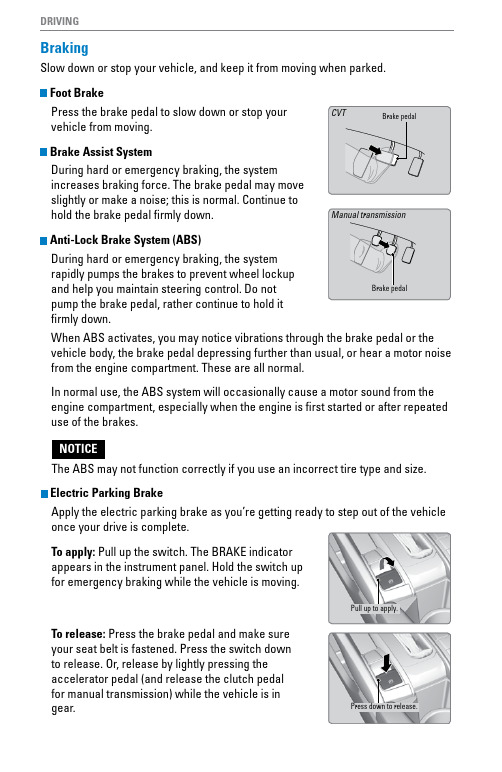
DRIVINGBrakingSlow down or stop your vehicle, and keep it from moving when parked. Foot BrakePress the brake pedal to slow down or stop your vehicle from moving. Brake Assist SystemDuring hard or emergency braking, the systemincreases braking force. The brake pedal may move slightly or make a noise; this is normal. Continue to hold the brake pedal firmly down. Anti-Lock Brake System (ABS)During hard or emergency braking, the system rapidly pumps the brakes to prevent wheel lockup and help you maintain steering control. Do not pump the brake pedal, rather continue to hold it firmly down.When ABS activates, you may notice vibrations through the brake pedal or the vehicle body, the brake pedal depressing further than usual, or hear a motor noise from the engine compartment. These are all normal.In normal use, the ABS system will occasionally cause a motor sound from the engine compartment, especially when the engine is first started or after repeated use of the brakes.The ABS may not function correctly if you use an incorrect tire type and size. Electric Parking BrakeApply the electric parking brake as you’re getting ready to step out of the vehicle once your drive is complete.To apply: Pull up the switch. The BRAKE indicator appears in the instrument panel. Hold the switch up for emergency braking while the vehicle is moving.To release: Press the brake pedal and make sure your seat belt is fastened. Press the switch down to release. Or, release by lightly pressing the accelerator pedal (and release the clutch pedal for manual transmission) while the vehicle is in gear.Pull up to apply.Press down to release.DRIVINGAutomatic Brake HoldUse brake hold to make stop-and-go driving easier. It maintains rear brake hold even after the brake pedal is released. Make sure the vehicle is on and your seat belt is fastened when operating this feature.1.Press the BRAKE HOLD button behind the shift lever. The BRAKE HOLD indicator appears in the instrument panel.2.With the shift lever in Drive (D) or Neutral (N), press the brake pedal and come to a complete stop. The HOLD indicator appears, and brake hold is applied. Release the brake pedal.Press the accelerator pedal (or shift into a gear and release the clutch pedal for manual transmission) to cancel brake hold and start moving.To turn off brake hold:Press the brake pedal and press the BRAKE HOLD button again.Automatic brake hold cancels when:•Braking is applied for more than 10 minutes.•The electric parking brake is engaged.•The foot brake is pressed and the shift lever* is moved to Park or Reverse.•The engine stalls (manual transmission).•The driver’s seat belt is unfastened.•The engine is turned off.•There is a problem with the automatic brake hold system.MAINTENANCEBrake/Clutch* FluidThe fluid level should be between the MIN and MAX marks on the side of the reservoir. We recommend using Honda Heavy Duty Brake Fluid DOT 3.Pour the fluid carefully.If the fluid level is at or below the MIN mark, have a dealer inspect for leaks or worn brake pads as soon as possible.The brake fluid reservoir is also used for your vehicle’s clutch fluid. As long as you keep the brake fluid level as instructed above, there is no need for checking the clutch fluid level.Brake fluid marked DOT 5 is not compatible with your vehicle’s braking system and can cause extensive damage.1.5 L engine modelsBrake Reserve TankMINMAX。
汽车驾驶员手册
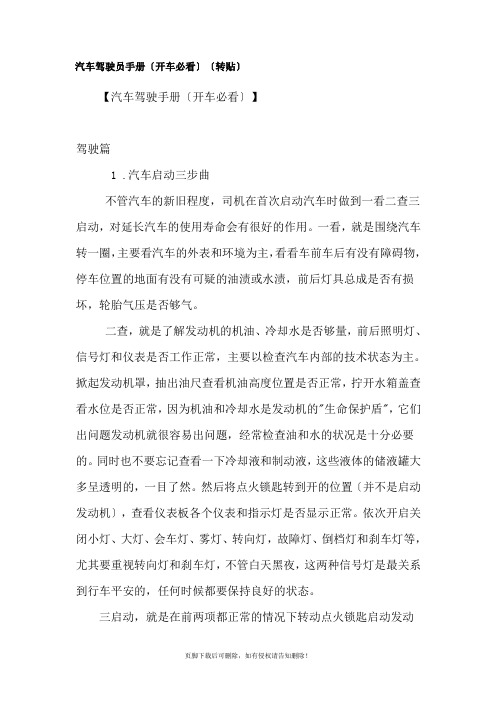
汽车驾驶员手册〔开车必看〕〔转贴〕【汽车驾驶手册〔开车必看〕】驾驶篇1 .汽车启动三步曲不管汽车的新旧程度,司机在首次启动汽车时做到一看二查三启动,对延长汽车的使用寿命会有很好的作用。
一看,就是围绕汽车转一圈,主要看汽车的外表和环境为主,看看车前车后有没有障碍物,停车位置的地面有没有可疑的油渍或水渍,前后灯具总成是否有损坏,轮胎气压是否够气。
二查,就是了解发动机的机油、冷却水是否够量,前后照明灯、信号灯和仪表是否工作正常,主要以检查汽车内部的技术状态为主。
掀起发动机罩,抽出油尺查看机油高度位置是否正常,拧开水箱盖查看水位是否正常,因为机油和冷却水是发动机的"生命保护盾",它们出问题发动机就很容易出问题,经常检查油和水的状况是十分必要的。
同时也不要忘记查看一下冷却液和制动液,这些液体的储液罐大多呈透明的,一目了然。
然后将点火锁匙转到开的位置〔并不是启动发动机〕,查看仪表板各个仪表和指示灯是否显示正常。
依次开启关闭小灯、大灯、会车灯、雾灯、转向灯,故障灯、倒档灯和刹车灯等,尤其要重视转向灯和刹车灯,不管白天黑夜,这两种信号灯是最关系到行车平安的,任何时候都要保持良好的状态。
三启动,就是在前两项都正常的情况下转动点火锁匙启动发动机,每次启动时间不要超过十来秒,这里要注意冷启动时,压油门要轻缓渐进,切忌一启动就立即加大油门使发动机转速急剧提升,因为冷启动时曲轴转速瞬间急升,机油来不及输送到轴瓦位置,容易造成轴瓦损伤。
发动机启动后,密切注意油压、水温、充电筹仪表或仪表灯的变化,待仪表符合正常值或仪表灯熄灭时就可以上档开动汽车了。
2.开车考前须知按照标准驾驶汽车,是行车平安的重要保障。
特别是对新司机来说,养成良好的驾驶习惯,可终生受益。
开车时,你有以下这些坏习惯吗?转向掏轮:汽车拐弯时,左手或右手反握方向盘,这样做虽然使转向省力,但遇汽车颠时,极易将手腕打伤,特别是回轮时,极易将手腕打伤,特别是回轮速度慢,极易发生交通事故。
- 1、下载文档前请自行甄别文档内容的完整性,平台不提供额外的编辑、内容补充、找答案等附加服务。
- 2、"仅部分预览"的文档,不可在线预览部分如存在完整性等问题,可反馈申请退款(可完整预览的文档不适用该条件!)。
- 3、如文档侵犯您的权益,请联系客服反馈,我们会尽快为您处理(人工客服工作时间:9:00-18:30)。
等级:版主
文章:2219
积分:14445
门派:古墓
注册:2006年6月16日
第 2 楼
两脚离合法
首先,变速换挡要牢记“加挡先加速,减挡先减速”的原则,在加挡前“轰”油门把车速先提起来,在减挡前“收”油门把车速先降下来。
外部检查 巡视汽车,检查灯泡及灯罩的损坏情况;检查车体饰物的固定情况;检查倒车镜的情况。
轮胎 检查轮胎的磨损情况,清理行李厢;接近轮胎的磨耗记号时应更换轮胎,检查轮胎有没有鼓包、异常主要磨损、老化裂纹和硬伤等情况。
清洁打蜡 彻底清扫汽车内部;清洁水箱外表、机油散热器外表和空调散热器外表上的杂物。
换档时机掌握的熟练程度的自我判断:
汽车移动后,在不使用离合器踏板的前提下,能够准确根据车速变化将5个档位随意变换,并且听不到明显齿轮撞击声响。
两脚离合现在也是场地赛减挡技巧之一,和跟趾动作有着相同的作用。在实际驾驶中,做不做两脚离合已经无所谓了,只要记得在换档时稍补点油或在空挡多停留一刻即可。这种动作对保护变速箱有莫大的帮助。2006-8-15
5、汽车行驶时将中央门锁锁死是安全的办法;错误,这是极其危险的办法,汽车一旦出现事故时,会打不开车门,因而危险率进一步提高。避免小偷抢夺车内的物品,最好在堵车时或等红绿灯的时候再将中央门锁锁死。
6、习惯泊车后只拉紧手刹;错误,在不平的地面泊车后不但要拉上手刹还要挂在档位上,这样才是防止汽车因路面不平避免下滑的最好办法。
7、在高速行驶的路面上速度越慢越安全;错误,如果驾驶的是小型轿车,速度慢于60km/h反而是不安全的,根据车的性能速度常保持在80-110km/h较安全。
8、开车行驶在最右边的道最安全;错误,这最不安全,因为遇到超车和从右手并上该道的情况比别的道上的车要多。
9、单向行驶时如果有双道,压虚线行驶最安全;错误,这最容易出现事故,因为无论是前后行驶的车辆无法判断你行驶的意图。
新车漆面虽无老化问题,但使用前应该做彻底的保护处理,从出厂到运输至停车场,车表漆就已经接触了空气、酸气、风沙的侵袭。及时正确的养护,能使爱车永葆青春。如果买的是进口轿车,要首先考虑的是车蜡中含有石蜡、树脂及特氟隆等材料。除蜡时不要用汽油或煤油擦拭,应选用专业的开蜡液,或者到专业的美容养护店,请技师帮助处理。至于国产车,车身大多采用青电喷涂,漆面呈镜面光泽,故无开蜡需要。
12、遇到其他驾驶不熟练者或违章者应通过喇叭或大灯提示他;错误,应该尽快远离他,按喇叭或大灯提示他只会增加他的紧张情绪,使他更加难以控制汽车。
13、拐弯或并道时应先看反光镜;错误,应先扭头看一下车的后面再看反光镜,因为,有时反光镜调矫的不好会有死角现象,此外,转向灯打开后会使靠近自己的车辆增加提速或放慢的几率,仅从反光镜不能完全判断正确性。
在换挡时,尽量采用“两脚离合法”,加挡时按照“踩(离合器)、摘(空挡)、踩(离合器)、挂(高速挡)”的原则,快速踩两脚离合器踏板,可以很轻松地增加挡位。
减挡时,按照“踩(离合器)、摘(空挡)、抬(离合器)、轰(油门)、踩(离合器)、挂(低速挡)”的原则,踩两脚离合器,并在第一脚离合器后轰一脚空油,并保持一会儿,然后再踩下第二脚离合器踏板,与此同时将变速杆变换到低速挡。
17、将驾驶座椅调的越靠近方向盘越有安全感;错误,这纯属心理作用,反而越靠近方向盘越容易增加紧张情绪,除不影响脚手操控外,驾驶座椅越远离方向盘越好,一是驾驶时的视觉更广大,左右眼的余光看到的会更多,二是座椅靠方向盘太近,必然绻着腿驾驶,长时间容易疲劳,三是出现紧急情况身子与汽车的操控台、方向盘缓冲的余地大,安全系数高。
信号装置检查打开点火开关钥匙(不起动发动机),检查各报警灯和指示灯的点亮情况,起动发动机查看各报警灯是否正常熄灭,指示灯是否还在点亮。
燃油检查 查看油量表的指示,补充燃油。
1.2. 每周的保养内容
轮胎气压 检查调整轮胎气压、清理轮胎上的杂物。不要忘记对备胎的检查。
发动机及各种油液
21、高速行驶时一边的轮子突然压到积水的路面很危险;错误,如果盲目踩刹车才危险,遇到这种情况控制好方向盘比踩刹车更重要和更安全的多。
22、光滑的路面应学会用好手刹和脚刹来控制汽车行驶;错误,应学会用好档位来控制汽车行驶。
23、空挡行驶时省油;错误,没有科学根据,熄火行驶才省油,但两者同样不安全。
底盘 检查底盘有没有漏油的现象,发现有漏油痕迹,应检查各总成的齿轮油量并进行适当的补充,对底盘所有的油嘴进行充分的补脂作业。
其他 细致重复每周的保养内容。
1.4. 每半年的保养内容
发动机外部
清洗发动机外表,清洗时注意对电气部分的防水处理。如果电气部分对防水要求较高的话,应避免用高压、高温的水枪来冲洗发动机,可以用毛刷沾清洗剂清洗发动机外表。
14、驾驶时抽烟,用左手拿烟顺手;错误,用左手只是往窗外弹烟灰顺手,应用右手,左手无论任何情况都不要分心操控方向盘。
15、开车时听音乐会分散驾驶者的注意力;错误,好的音响设施和自己喜欢的音乐能进一步抑制疲劳的精神状态,能进一步调整更好的心理状态。
16、开车行驶时只注意保持前后车辆的距离;错误,除了保持与前后的安全距离外,还应尽量避免与左右手的车辆保持并列行驶,通过提速超车或放慢速度来错开并列行驶者,并列行驶的最大坏处是分心,容易使注意力从前方分散到左右,对初学驾驶者更容易造成紧张不安的情绪。
《汽车驾驶手册》[大嘴车坛]恢复默认设置dvbbs收藏本页
联系我们
论坛帮助 dvbbs恢复默认设置
登录注册 搜索风格论坛状态道具中心我能做什么
>> 汽车超级读本力求全面、正确的反映最实用的汽车知识,给广大有车族提供有益的帮助。 大嘴车坛 → 车坛 → 『 汽车超级读本 』 → 《汽车驾驶手册》
紧固 检查底盘重要螺栓或螺线的紧定情况,特别是转向系统的重要螺栓和螺线,发现有松动或缺损情况,应补齐拧紧。
底盘 检查底盘各部分管路情况,查看有没有泄漏,检查紧固所有金属连接杆件,并检查橡胶轴套有没有损坏的情况,对底盘所有润滑点进行补脂润滑。
11:26:00 水晶翅膀
等级:版主
文章:2219
积分:14445
门派:古墓
注册:2006年6月16日
第 4 楼
保养内容周期
1.1. 每天的保养内容
外观检查
在出车前,环视汽车,看看灯光装置有没有损坏,车身有没有倾斜,有没有漏油、漏水等泄漏情况;检查轮胎的外表情况;检查车门、发动机仓盖、行理仓盖和玻璃的状况。
10、高速拐弯时一边踩离合器一边踩刹车行驶最安全;错误,不可踩离合器,无论任何情况下,踩离合器行驶会增加汽车的惯性,应该将档位放低后再踩着刹车行驶。
11、汽车加装abs系统后是为了缩短刹车距离;错误,abs最大的优点不是缩短刹车距离,而是防止轮胎暴死,因此,即便遇到特殊情况将刹车踩死,其方向盘也是可以操控汽车的方向,学会紧急刹车后缓冲这段刹车的距离是认识abs的关键所在。
第一次清洗爱车不能马虎,清洗不当,会损伤外层的亮油部分,那车就不是越洗越亮而是越洗越暗了。最好是去无尘手工洗车房,选用中性温和的洗净剂,把车漆表面的沙粒、污物清除干净。有些污物是用肉眼看不出来的,像飞漆、树胶、碱、酸等化学成分的污染,都应当彻底清除,只是简单的用洗净剂是去不掉的,必须用专用去污粘土一点点地擦拭。全车清理完毕,再用震抛机把釉封入车漆。这是一项新技术,封完釉的车一年之内不用再打蜡,只用清水清洗后用干净的麂皮布擦干即可,而且防氧化、防紫外线、保持车漆不会褪色。最后可在轮胎、保险杠、轮眉等部位涂上相应的保护剂,以防老化。2006-8-15
2、夜晚远光灯越强行驶越安全;错误,灯光的照射角度越大越安全,灯光抬的越高越亮越危险。
3、常常使用大油门对发动机不好;错误,发动机在档位上转速经常提到4000以上不但无害,还对发动机有一定的好处,常常空档踩油门或长时间在高转速上才对发动机不好。
4、习惯性踩离合器是减少麻烦的办法;错误,习惯性踩离合器不但对机器不好,反而麻烦会更多,更重要的是不安全。
检查发动机各部件的固定情况,查看发动机各结合面有没有漏油、漏水的情况;检查调整皮带紧度;查看各部位的管路和导线固定情况;检查补充机油;检查补充冷却液;检查补充电解液;检查补充动力转向机油;清洁散热器外表;补充风挡玻璃清洗液等。
清洁 清洁汽车内部,清洗汽车外表。
1.3. 每月的保养内容
18、除车窗反光镜的位置不贴太阳膜外,在其他地方大面积贴太阳膜不影响驾驶;错误,驾驶者的视线不光是前方,侧面和后方同样需要经常看,影响驾驶者的视线增就增了加危险的程度,此外还会减少驾驶者的乐趣。
19、驾驶室内的反光镜是为了看后座的人;错误,是为了看后面行驶的车辆和左右反光镜的死角。
20、无论任何情况1挡起步好;错误,光滑的路面用2档容易起步,此外,在光滑的路面用1挡当刹车比直接刹车效果更好。
电瓶 检查蓄电池接线柱部分有没有腐蚀的现象,用热水冲洗蓄电池外表,清除蓄电池接线柱上腐蚀物。测量调整蓄电池的电解液比重。
冷却液 检查补充冷却液、清洁水箱外表。
轮胎轮毂 检查轮胎的磨损情况,对轮胎实施换位。检查轮毂、轴承预紧情况,如有间隙应调整预紧度。
制动系统
检查调整手制动拉杆工作行程;检查调整鼓式手制动器的蹄片间隙;检查调整脚制动踏板的自由行程;检查车轮制动器蹄片磨损情况,如果达到磨耗记号应更换制动蹄片;检查调整车轮制动器蹄片间隙;检查补充制动液等。
11:25:00 水晶翅膀
等级:版主
文章:2219
积分:14445
门派:古墓
注册:2006年6月16日
第 3 楼
买了新车之后首次养护不能马虎
买了一辆新车,车主往往会先将车内装饰得美仑美奂,而忽略了车体本身的养护。其实首次车体养护和开蜡,往往是日后用车养车的质量保证,如果开始保养得不好,以后也会出现许多问题。
